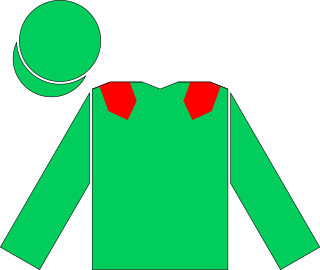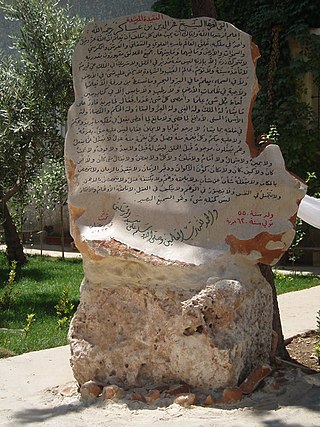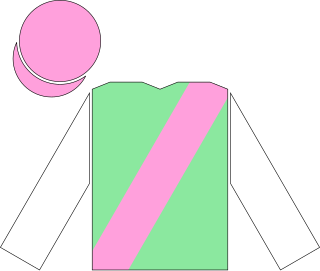Shahrastani may refer to:
- al-Shahrastani (1086–1153), Persian historian
- Shahrastani (horse) (1983–2011), Thoroughbred racehorse
Shahrastani may refer to:

Year 1086 (MLXXXVI) was a common year starting on Thursday of the Julian calendar.
Abū Muḥammad Ismāʿīl ibn Jaʿfar al-Mubārak was the eldest son of Ja'far al-Sadiq and the sixth Imam in Isma'ili Shia Islam. He also carried the epithet of al-Mubarak, on the basis of which one of the earliest Isma'ili groups became designated as the Mubarakiyya.

The Dante Stakes is a Group 2 flat horse race in Great Britain open to three-year-old horses. It is run over a distance of 1 mile, 2 furlongs and 56 yards at York in May.

Shahrastani (1983–2011) was an American-bred, British-trained Thoroughbred racehorse. He won four of his seven races between September 1985 and October 1986. He is best known for his performances in the summer of 1986 when he defeated Dancing Brave in the Epsom Derby and went on to win the Irish Derby by eight lengths. At the end of the season he was retired to stud, but made little impact as a stallion. He died in 2011.

Dancing Brave was an American-bred, British-trained thoroughbred racehorse. In a racing career which lasted from the autumn of 1985 until October 1986, he ran ten times and won eight races. Dancing Brave was the outstanding European racehorse of 1986, when he won the 2000 Guineas, the Eclipse Stakes, the King George VI and Queen Elizabeth Stakes and the Prix de l'Arc de Triomphe. His only defeats came in the Derby and the Breeders' Cup Turf. A successful sire of winners in Europe, he was later exported to Japan, where he died on 2 August 1999.
Sir Michael Ronald Stoute is a Barbadian British Thoroughbred horse trainer in flat racing.
In theology or the history of religion, heresiology is the study of heresy, and heresiographies are writings about the topic. Heresiographical works were common in both medieval Christianity and Islam.
Tāj al-Dīn Abū al-Fath Muhammad ibn `Abd al-Karīm ash-Shahrastānī, also known as Muhammad al-Shahrastānī, was an influential Persian historian of religions, a historiographer, Islamic scholar, philosopher and theologian. His book, Kitab al–Milal wa al-Nihal was one of the pioneers in developing an objective and philosophical approach to the study of religions.
Abu Isa was a self-proclaimed Jewish prophet sometime in the 8th century CE in Persia and the leader of a short-lived revolt. Proclaimed by some of his followers to be the Messiah, Abu Isa himself never made such claims or inferences. He seems to have allied himself with Sunbadh after the assassination of Abu Muslim in 755 CE. His forces fought Caliph al-Mansur's army at Rayy only to be defeated. Abu Isa fell in this battle.
Kitāb al–Milal wa al-Nihal, written by the Islamic scholar Muhammad al-Shahrastani, is a non-polemical study of religious communities and philosophies that had existed up to his time, considered to be the first systematic study of religion. It was written around 1127-1128 and divides religions between sects, which have written doctrines, and creeds which do not.

Al-Nizamiyya of Baghdad, one of the first nizamiyehs, was established in 1065 in Baghdad. In July 1091, Nizam al-Mulk appointed the 33-year-old al-Ghazali as a professor of the school. Offering free education, it has been described as the "largest university of the Medieval world". Ibn Tumart, founder of the Berber Almohad dynasty, reputedly attended the school and studied under al-Ghazali and Al-Kiya al-Harrasi. Nizam al-Mulk's son-in-law Mughatil ibn Bakri was also employed by the school. In 1096, when al-Ghazali left the nezamiyeh, it housed 3,000 students. In 1116, Muhammad al-Shahrastani taught at the nezamiyeh. In the 1170s, statesman Beha ud-Din taught at the nezamiyeh, before he moved on to teach in Mosul, while Imad ad-Din al-Isfahani studied there in the late 12th century.

Fażlu l-Lāh Astar-Ābādī, also known as Fażlullāh Tabrīzī Astarābādī by a pseudonym al-Ḥurūfī and a pen name Nāimī, was an Iranian mystic who founded the Ḥurūfī movement. The basic belief of the Ḥurūfiyyah was that the God was incarnated in the body of Fażlullāh and that he would appear as Mahdī when the Last Day was near in order to save Muslims, Christians and Jews. His followers first came from the village of Toqchi near Isfahan and from there, the fame of his small community spread throughout Khorasan, Iraq, Azerbaijan and Shirvan. The center of Fażlullāh Nāimī's influence was Baku and most of his followers came from Shirvan. Among his followers was the famous Ḥurūfī poet Seyyed Imadaddin Nasimi, one of the greatest Turkic mystical poets of the late 14th and early 15th centuries.
The Haynes, Hanson and Clark Conditions Stakes is a flat horse race in Great Britain open to two-year-old colts and geldings. It is run at Newbury over a distance of 1 mile, and it is scheduled to take place each year in September.
The 1986 Epsom Derby was a horse race which took place at Epsom Downs on Wednesday 4 June 1986. It was the 207th running of the Derby, and it was won by Shahrastani. The winner was ridden by Walter Swinburn and trained by Michael Stoute. The prerace favourite Dancing Brave finished second.
Taj al-Din may refer to:
Dāwūd bin ʿAlī bin Khalaf al-Ẓāhirī was a Persian Muslim scholar, jurist, and theologian during the Islamic Golden Age, specialized in the study of Islamic law (sharīʿa) and the fields of hermeneutics, biographical evaluation, and historiography of early Islam. He is widely regarded as the founder of the Ẓāhirī school of thought (madhhab), the fifth school of thought in Sunnī Islam, characterized by its strict adherence to literalism and reliance on the outward (ẓāhir) meaning of expressions in the Quran and ḥadīth literature; the consensus (ijmāʿ) of the first generation of Muhammad's closest companions (ṣaḥāba), for sources of Islamic law (sharīʿa); and rejection of analogical deduction (qiyās) and societal custom or knowledge (urf), used by other schools of Islamic jurisprudence. He was a celebrated, if not controversial, figure during his time, being referred to in Islamic historiographical texts as "the scholar of the era."

The 1986 Prix de l'Arc de Triomphe was a horse race held at Longchamp on Sunday 5 October 1986. It was the 65th running of the Prix de l'Arc de Triomphe.

The 1986 King George VI and Queen Elizabeth Stakes was a horse race held at Ascot Racecourse on Saturday 26 July 1986. It was the 36th running of the King George VI and Queen Elizabeth Stakes.
The Bishriyya was a sub-sect of the Mu'tazilite school of Islamic theology.
The Yudghanites ("Al-Yudghaniyyah") were a Jewish sect named after its founder, Yudghan or Judah of Hamadan, a disciple of Abu Isa al-Isfahani.